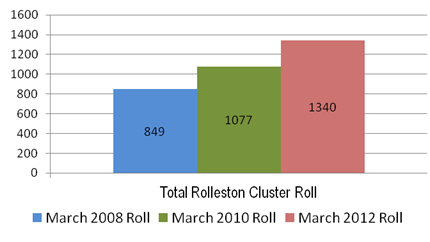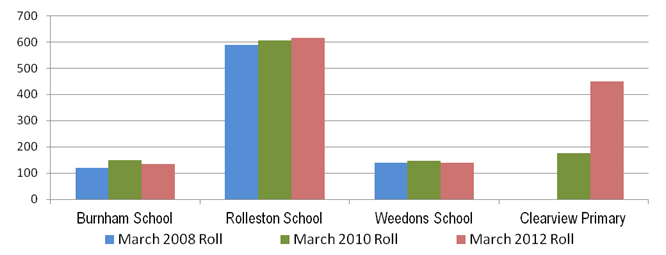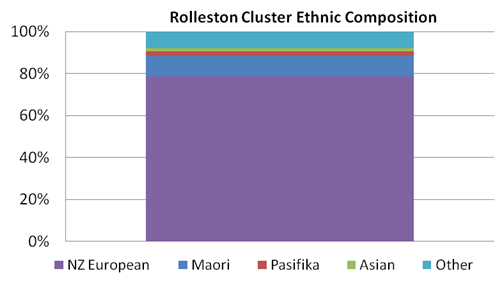Rolleston Learning Community Cluster
This learning community cluster includes four state primary schools and 13 early childhood education providers.
As part of renewal planning, the Minister of Education has announced a final decision for Burnham School to remain open.
Burnham School accepted their interim decision and received a final decision from the Minister in March 2013.
Supporting information for final decision
- Burnham School Education Report [PDF; 14.9mb]
- Burnham School Submissions [PDF; 21mb]
Documents are available in PDF format only. Accessible versions can be supplied on request from info@minedu.govt.nz
The map below shows the current makeup of the learning community cluster.
[iframe][/iframe]Schooling
Early childhood education (ECE)
There are 680 licensed spaces across the early childhood education (ECE) providers in this cluster, including 166 spaces for children under two years of age. At July 2011, 705 children were enrolled at early childhood services in this cluster, 120 were under two. Of the 197 new entrants who enrolled at a school in the Rolleston Cluster in the year to March 2012, 195 (99%) had attended an ECE service. Twenty three of the 25 Māori new entrants (92%) and all of the four Pasifika new entrants had attended an ECE service.
Services
- Kidsfirst Kindergarten Burnham
- Rolleston Playcentre
- ABC Rolleston
- Bright Beginnings Montessori Brookside
- Bright Beginnings Montessori Nursery
- Burnham Country Montessori
- Burnham Nursery and Preschool
- Magic Milestones Early Learning Centre
- Paradise for Little Angels
- Rolleston First Learners
- Rollykids Early Learning Centre
- Selwyn Toddlers Kindergarten
- The Cat’s Pyjamas Preschool
ECE services are independently owned and managed.
School governance
There are three types of schools: state, private (or registered or independent) and state integrated schools. State integrated schools are former private schools which, while now “integrated” into the state system, also provide programmes around their particular religious or learning philosophy.
State and state integrated schools, while government funded, are managed by boards of trustees. Private schools receive only partial funding from the Government. Day to day management of all schools is the responsibility of the principal.
The Crown is responsible for property provision for state schools to ensure students have access to their closest school. The proprietors of state integrated and private schools are responsible for their own buildings.
The Rolleston cluster does not include any state integrated schools. School boards are required to develop individual charters and annual plans and report their performance against these. School boards are required to develop individual charters and annual plans and report their performance against these. You will be able to access the school charter from your school or on Find a school.
Education Review Office (ERO) reports on school and early childhood performance are publicly available.
Rolleston cluster ERO review cycle
| Burnham School | 3 years |
| Clearview Primary | 3 years |
| Rolleston School | In progress |
| Weedons School | 3 years |
School roll changes
In March 2010, prior to the earthquakes, the primary schools in this cluster provided teaching and learning to 1077 students. While individual rolls have fluctuated, the combined primary roll in this cluster has increased by 263 to 1340 at March 2012.
Individual school March rolls, 2008, 2010, and 2012:
Note: only roll data for primary schools in this cluster is displayed.
The following chart shows the ethnic composition of the combined cluster school rolls by percentage of total combined roll
Education achievement
National Standards aim to lift achievement in literacy and numeracy (reading, writing, and mathematics) by being clear about what students should achieve and by when. Boards are required to report on learner’s achievement for 2011, in their 2012 Annual Report. You will be able to access National Standards data for your school from the Find a school section of the Education Counts website as soon as this information is available.
Special Education
Special Education delivers specialist services and support to learners with special education needs across this cluster. This includes support to early childhood education, schools, teachers, parents, families and whānau.
Māori and Pasifika provision
Māori-medium education programmes involve students being taught either all or some curriculum subjects in the Māori language, either in immersion (Māori language only) or bilingual (Māori and English) programmes.There are no Māori or Pasifika bilingual units, or language programmes delivered by schools in this cluster.
English for speakers of other languages (ESOL) provision
ESOL provision for refugee and new migrant learners from non-English speaking backgrounds is not provided in this cluster.
Technology
There is no specific technology provision located in this cluster. Schools are likely to be accessing it in neighbouring clusters.
Land – State schools only
School sites sit outside the Canterbury Earthquake Recovery Authority (CERA) land classification process and will not be given any Technical Category foundation rankings. The land in the surrounding residential area has not been classified by the Canterbury Recovery Authority (CERA).Geotechnical assessments on the state school sites in this cluster indicate land issues will not compromise continued education provision.
Further Ministry commissioned assessments may be required at a later date, should any of these sites be further developed.
Buildings – State schools only
There are 67 teaching spaces included in the 8,379 square metres (of useable space) of teaching and learning and administration areas across this cluster of schooling provision. The teaching, learning and administrative space is incorporated into 42 actual buildings. The majority of these buildings suffered damage during the earthquakes. Some repairs have yet to be made to the building stock. Condition assessments confirm over time earthquake strengthening will be required across five of these buildings within the cluster. There are weather tightness issues in a further seven buildings.
Building condition information – State schools only
| Number of buildings | Number of buildings with EQ damage | Number of buildings with strengthening required | Number of buildings with weather tightness repairs required | Number of buildings with both strengthening and weather tightness repairs | |
|---|---|---|---|---|---|
| Burnham | 8 | 4 | 3 | 0 | 0 |
| Clearview | 5 | 5 | 0 | 0 | 0 |
| Rolleston | 21 | 13 | 1 | 7 | 0 |
| Weedons | 8 | 5 | 1 | 0 | 0 |
| Cluster | 42 | 27 | 5 | 7 | 0 |
Based on March 2012 rolls – a minimum of 56 teaching spaces will be required for ongoing teaching and learning in this cluster.
School rolls and classroom numbers – State schools only
| 2010 roll | Classroom (no.) current (July 2012) | March 2012 roll | Estimated classrooms required at March 2012 * | |
|---|---|---|---|---|
| Burnham | 150 | 9 | 136 | 6 |
| Clearview | 176 | 17 | 450 | 19 |
| Rolleston | 605 | 35 | 615 | 25 |
| Weedons | 146 | 6 | 139 | 6 |
| Cluster | 1077 | 67 | 1340 | 56 |
The way forward
Extensive condition assessments and engineering investigations have confirmed all buildings in this cluster currently remain fit to occupy – unless already isolated.A number of the buildings across this cluster will, however, require remediation and strengthening over the longer-term. Four are not considered cost effective to repair. This includes 16 teaching spaces.
Future planning
The earthquakes provide an opportunity, as outlined in the Education Renewal Recovery Programme [PDF; 881kb], to consider options for revitalising the greater Christchurch education network that go beyond simply replacing what was there. Discussions with schools, communities and providers within this cluster will be key to informing decisions around the future shape of education for the Rolleston education community. Ways to enhance infrastructure and address existing property issues, improve education outcomes, and consider future governance will form part of these discussions.
Community engagement
The Ministry of Education will formally consult with this cluster and communities on the possible shape of future education provision. This will include providing detailed information on the issues and options affecting each individual cluster for community consideration. In line with the support signalled in the Education Renewal Recovery Programme [PDF; 881kb] for improved collaboration, this will provide an opportunity to gain further suggestions around shared provision across schools and services within specific areas of interest and the wider community, as appropriate. Boards will formally consult with their communities where closures or mergers are indicated.
Check out the engagement schedule for further details.
Secondary schools
Secondary, state integrated and independent schools located within these clusters will be involved in discussions around the future shape of provision within their education communities.
The Ministry has worked collaboratively with secondary schools on ideas for future secondary school education provision in greater Christchurch. In October 2013, the Minister of Education announced decisions for the secondary school network.


